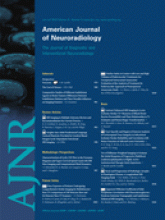Abstract
BACKGROUND AND PURPOSE: Spinal MRA has been increasingly used to evaluate non-invasively the spinal cord vasculature. Our aim was to prospectively compare gadobenate dimeglumine with gadodiamide in the assessment of the normal spinal cord vasculature by using contrast-enhanced MRA, with the hypothesis that high T1 relaxivity gadolinium compounds may improve visualization of the intradural vessels.
MATERIALS AND METHODS: Twenty subjects underwent 2 temporally separated contrast-enhanced spinal MRAs with gadobenate dimeglumine and gadodiamide (0.2 mmol/kg). Two blinded observers rated postprocessed images on the following qualitative parameters: background homogeneity, sharpness, vascular continuity, and contrast enhancement. Delineation of the ASA, AKA, hairpin configuration of the ASA-AKA connection, and visualized ASA length were recorded. Each observer indicated which of the 2 matched studies he or she thought was of the best overall diagnostic quality.
RESULTS: According to both observers gadobenate dimeglumine was superior to gadodiamide in the representation of vascular continuity and contrast (P value < .05). Background homogeneity was not significantly different between the studies. One observer favored gadobenate dimeglumine over gadodiamide in the demonstration of vascular sharpness, while the second observer did not find any significant difference between contrast agents. There was no significant difference between contrast agents in the visualization of the ASA, AKA, hairpin-shaped ASA-AKA connection, and visualized length of the ASA. The overall quality of the gadobenate dimeglumine–enhanced MRA was deemed superior in 15 and 16 cases, respectively, by the 2 observers.
CONCLUSIONS: Improved image quality and vascular contrast enhancement of spinal MRA at 1.5T is achieved with high T1 relaxivity gadolinium contrast agents compared with conventional agents at equivalent doses.
Abbreviations
- AKA
- artery of Adamkiewicz
- ASA
- anterior spinal artery
- DSA
- digital subtraction angiography
- G
- gadodiamide
- GD
- gadobenate dimeglumine
- MRA
- MR angiography
- Copyright © American Society of Neuroradiology












